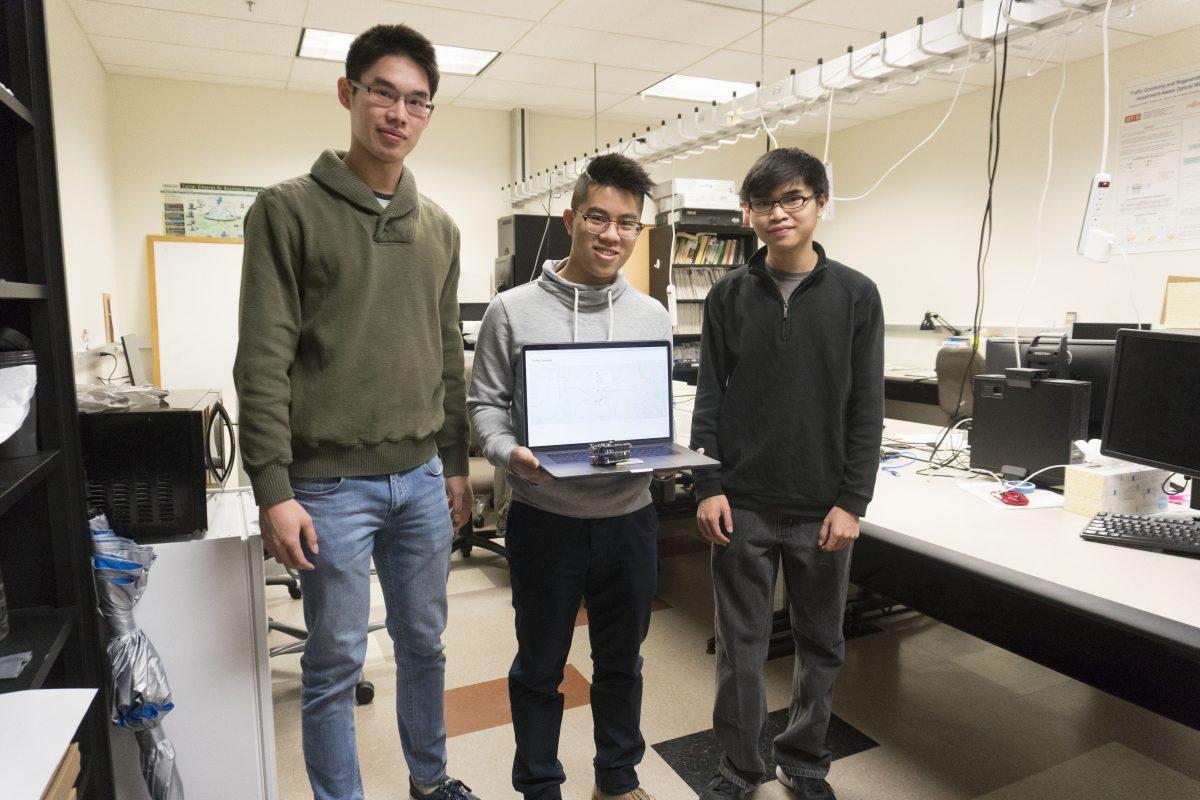A team of computer science students were recognized in an international competition after developing a device detecting car crashes and alerts emergency services automatically. The achievement makes UTD one of three schools in the United States to win an award at the competition this year.
Computer science juniors Tam Nguyen and Caleb Fung, freshman David Hong and Daniel Zhang and graduate Ashkan Yousefpour, who are all members of the Advanced Network Research Laboratory in the computer science department, entered the device into a contest hosted by the IEEE Communications Society. The competition recognizes student teams whose projects showed the possibility of improving the peoples’ lives through the applications of communications technology.
“It was pretty insightful trying to see how the things we were learning and how we can use all the technologies we have to help better the world,” Nguyen said. “And that was the goal of the competition.”
The device can measure and record the car’s speed, location and G-force. Using the values, the device can detect car crashes and potholes on the road. If the values pass a certain threshold, the device classifies the movement as one caused by a car crash. If they fall under the threshold, it is recorded as a pothole. The device can also send all the collected data to a server that is used for analytics.
Their project, “Instant Accident Reporting and Crowdsensed Road Condition Analytics for Smart Cities,” was awarded honorary mention and recognized as one of top the nine projects submitted in an international competition.
For all of the undergraduate students, the first major team project they contributed to was the competition. As members of the Advanced Network lab, they regularly conduct research and contribute their works to the IEEE science journals.
“We stopped our focus with the papers for a bit just to clear our minds, and we thought it’d be fun to do a hands-on project,” Nguyen said. “I got to learn about technology and the world itself, and it was very eye-opening to see how much goes into just one little device.”
At the start of the summer, the team members decided to create the device after numerous brainstorming sessions. Yousefpour, the graduate student who served as a mentor for the undergraduate students, said the members had to take into account the project’s practicality and feasibility.
“We came up with many ideas,” Yousefpour said. “One of them involved drones that would measure if parking spots are free. Then we figured out that the idea is nice, but implementing that may not be that easy.”
The team members started the brainstorming sessions by noticing problems people encountered in everyday life. Nguyen said he thought of a pothole near his family home that remained unfilled for several months, even though it was causing problems for people in the neighborhood, including his father.
“We thought, ‘Hey, what if we can make something to report that on its own?’” Nguyen said. “And that idea branched out more and more.”
Although the team members produced a working model in the end, they had difficulties during the process, such as the initial model’s inability to provide a Bluetooth connection. To solve the problem, the team put another hardware kit on top of the initial model, so that the final product has two layers. Another setback was that the team members could not simulate an actual car crash just to test the device, so the device was scaled according to numerical values found by research. The members simulated crashes and potholes by physically shaking the device with their hands.
Although the process of creating the technology presented obstacles, the members of the team overcame them as each member had a specific role to play in the project.
“Having a team of diverse people with different backgrounds definitely helped because we had some people who worked on the hardware that others have much knowledge about, and some other people worked on software while some people made the video,” Yousefpour said.
Yousefpour also said the competition has been a good experience for him and other members to hone leadership skills and responsibilities. He also said that the team’s accomplishment in the recent competition has helped with the team’s morale.
“When the project was selected, all of us felt so accomplished,” he said. “So if there is another competition, all of us will go for it because now we have a positive feeling about this whole thing.”
In the future, Fung said he would want to propose their project to the city of Richardson or Dallas area traffic department, as the device’s ability to collect information about crashes and potholes and send them to a server real-time could be beneficial for city authorities. The server displays exactly which roads are backed up and which routes need to be avoided. In addition, the device can also help the drivers in accidents because it allows emergency services to be dispatched immediately.
“There are multiple accidents that happen where no bystander is there to call,” Nguyen said. “The good thing about this device is that it doesn’t require a bystander. If it registers a crash, it does everything on its own.”
The technology of the device is not far from being implemented. Yousefpour said that the team wanted to make a device that people with less expensive cars can buy and plug into their cars, and that cities could potentially provide the device to drivers for free.
“This device could make a big difference in terms of making someone’s day better or potentially saving their lives,” Fung said.











